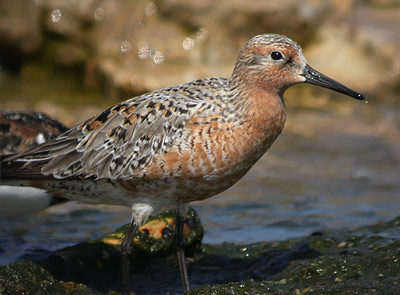
The following was a comment to The Horseshoe Crab and Shorebird Connection:
"While I agree that horseshoe crabs have been over-harvested in the New Jersey and Delaware area, I am not convinced that this is a major factor of the declining number of shorebirds. There was also a study that indicated that it was from the use of DDT that caused the eggs to have thinner shells. This caused a high mortality rate for newborn birds. I do however think that there should be a limit on the harvest of horseshoe crabs by both the fishing industry and the biomedical industry. This would ensure the survival of the species."
A shorebird attracting a lot of media attention and experiencing a sharp population decline is the rufa subspecies of the Red Knot. Without appropriate action, it's thought this shorebird faces probable extinction as early as 2010. With regard to DDT contamination, I was unable to find a specific red knot study, but there have been some preliminary ones focusing on shorebirds. In 1984, limited data collected from several shorebird species in Alaska indicated higher presence of contaminants than non-shorebirds. However in 2002, contaminant concentrations in shorebird eggs were found to be low or non-detectable. This particular Alaskan Fish and Wildlife study was slated to be expanded from 2002 and 2005, but I discovered after contacting their office that they lacked the necessary funding in order to complete the research.
There are various articles on-line about shorebirds contaminated by DDT and other pesticides on their wintering grounds in South America, but this seems to be confined to shorebirds on or near agricultural fields. I contacted a few shorebird specialists, including Dr. Richard Lanctot, Alasaka region shorebird coordinator, and each independently offered a similar response. Pesticides like DDT are used in agricultural interior sites and not coastal regions where red knots concentrate; therefore DDT contamination is unlikely to be the primary reason for such dramatic declines. Backed up by strong supporting evidence, the most obvious reason is lack of appropriate food - horseshoe crab eggs. Around 80% of the rufa subspecies of red knot stopover at Delaware Bay to refuel before continuing northward. Without enough of this necessary food source to fatten them up for their final leg of migration, it's very likely that many birds perish before reaching breeding grounds.
Red Knot image © 2008 Tom Prestby

















